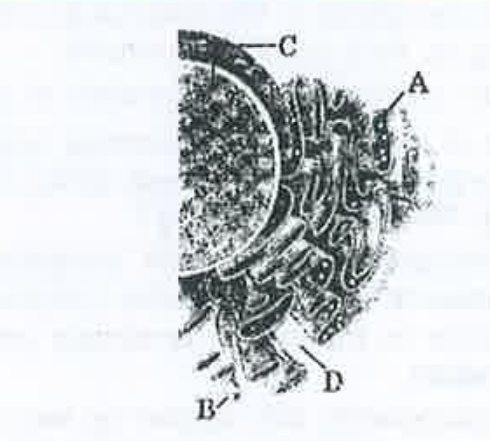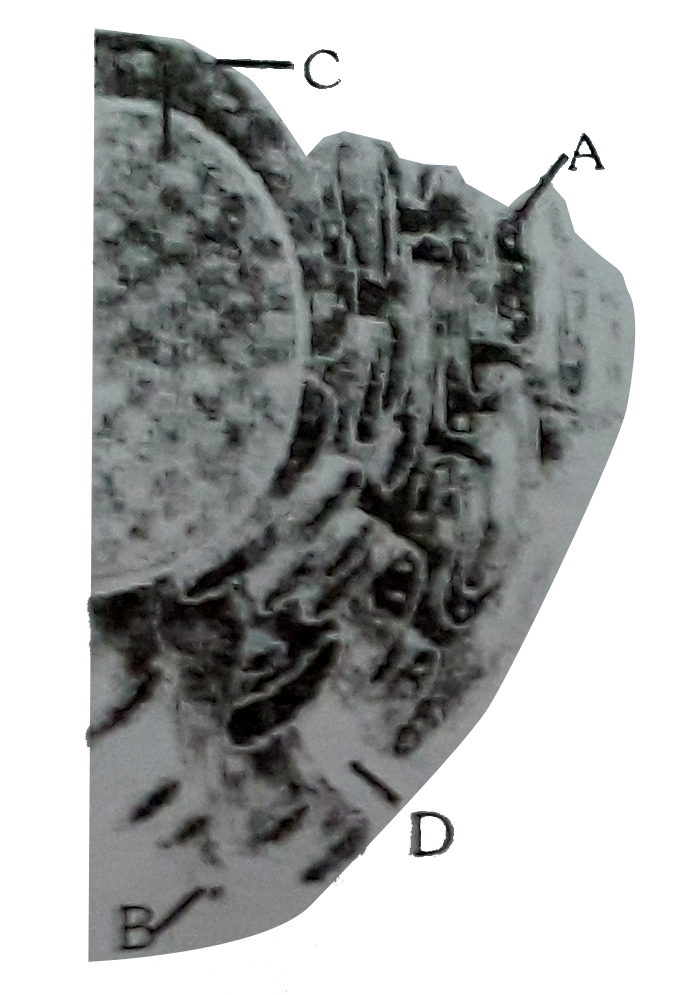With which family and/or flower will you associate the features listed below?
(i) Epicalyx (ii) diadelphous condition (iii) parietal placentation (iv) monoadelphous condition (v) cruciform petals (vi) obliquely placed ovary (vii) marginal placentation (viii) tetradynamous stamens (ix) papilionaceous corolla.
To associate the features listed in the question with their respective families and flowers, we can analyze each feature step by step:
1. Epicalyx:
- Definition: An epicalyx is a whorl of bracts that is found outside the calyx.
- Associated Family/Flower: This feature is associated with the Malvaceae family, specifically the flower Hibiscus.
2. Diadelphous Condition:
- Definition: This refers to the condition where stamens are united in two bundles.
- Associated Family/Flower: This is characteristic of the Fabaceae family, commonly seen in the pea plant.
3. Parietal Placentation:
- Definition: In parietal placentation, the ovules develop on the inner wall of the ovary.
- Associated Family/Flower: This feature is found in the Brassicaceae family, with the mustard flower as an example.
4. Monadelphous Condition:
- Definition: This condition involves stamens that are fused into a single group or tube.
- Associated Family/Flower: It is associated with the Malvaceae family, particularly in Hibiscus.
5. Cruciform Petals:
- Definition: Cruciform petals are arranged in a cross shape, typically with four petals.
- Associated Family/Flower: This feature is also found in the Brassicaceae family, exemplified by the mustard flower.
6. Obliquely Placed Ovary:
- Definition: An ovary that is positioned at an angle rather than vertically.
- Associated Family/Flower: This is characteristic of the Solanaceae family, with the eggplant flower as an example.
7. Marginal Placentation:
- Definition: In marginal placentation, ovules are attached along the margin of the ovary.
- Associated Family/Flower: This feature is found in the Fabaceae family, with the pea plant as an example.
8. Tetradynamous Stamens:
- Definition: This refers to a flower having four long stamens and two short stamens.
- Associated Family/Flower: This feature is characteristic of the Brassicaceae family, commonly seen in the mustard flower.
9. Papilionaceous Corolla:
- Definition: This describes a butterfly-like corolla, which is irregular and has distinct petal shapes.
- Associated Family/Flower: This feature is associated with the Fabaceae family, particularly in flowers like the pea plant.
Summary of Associations:
- Epicalyx: Malvaceae (Hibiscus)
- Diadelphous Condition: Fabaceae (Pea plant)
- Parietal Placentation: Brassicaceae (Mustard flower)
- Monadelphous Condition: Malvaceae (Hibiscus)
- Cruciform Petals: Brassicaceae (Mustard flower)
- Obliquely Placed Ovary: Solanaceae (Eggplant)
- Marginal Placentation: Fabaceae (Pea plant)
- Tetradynamous Stamens: Brassicaceae (Mustard flower)
- Papilionaceous Corolla: Fabaceae (Pea plant)
- Definition: An epicalyx is a whorl of bracts that is found outside the calyx.
- Associated Family/Flower: This feature is associated with the Malvaceae family, specifically the flower Hibiscus.
- Definition: This refers to the condition where stamens are united in two bundles.
- Associated Family/Flower: This is characteristic of the Fabaceae family, commonly seen in the pea plant.
- Definition: In parietal placentation, the ovules develop on the inner wall of the ovary.
- Associated Family/Flower: This feature is found in the Brassicaceae family, with the mustard flower as an example.
- Definition: This condition involves stamens that are fused into a single group or tube.
- Associated Family/Flower: It is associated with the Malvaceae family, particularly in Hibiscus.
- Definition: Cruciform petals are arranged in a cross shape, typically with four petals.
- Associated Family/Flower: This feature is also found in the Brassicaceae family, exemplified by the mustard flower.
- Definition: An ovary that is positioned at an angle rather than vertically.
- Associated Family/Flower: This is characteristic of the Solanaceae family, with the eggplant flower as an example.
- Definition: In marginal placentation, ovules are attached along the margin of the ovary.
- Associated Family/Flower: This feature is found in the Fabaceae family, with the pea plant as an example.
- Definition: This refers to a flower having four long stamens and two short stamens.
- Associated Family/Flower: This feature is characteristic of the Brassicaceae family, commonly seen in the mustard flower.
- Definition: This describes a butterfly-like corolla, which is irregular and has distinct petal shapes.
- Associated Family/Flower: This feature is associated with the Fabaceae family, particularly in flowers like the pea plant.
- Epicalyx: Malvaceae (Hibiscus)
- Diadelphous Condition: Fabaceae (Pea plant)
- Parietal Placentation: Brassicaceae (Mustard flower)
- Monadelphous Condition: Malvaceae (Hibiscus)
- Cruciform Petals: Brassicaceae (Mustard flower)
- Obliquely Placed Ovary: Solanaceae (Eggplant)
- Marginal Placentation: Fabaceae (Pea plant)
- Tetradynamous Stamens: Brassicaceae (Mustard flower)
- Papilionaceous Corolla: Fabaceae (Pea plant)
Topper's Solved these Questions
- MORPHOLOGY OF FLOWERING PLANTS BOOK - ICSECHAPTER - MORPHOLOGY OF FLOWERING PLANTS EXERCISE - REVIEW QUESTIONS (V. LONG ANSWER TYPE QUESTIONS)
6 Videos
- MORPHOLOGY OF FLOWERING PLANTS BOOK - ICSECHAPTER - MORPHOLOGY OF FLOWERING PLANTS EXERCISE - NCERT TEXTBOOK QUESTIONS WITH SOLUTIONS
25 Videos
- MORPHOLOGY OF FLOWERING PLANTS BOOK - ICSECHAPTER - MORPHOLOGY OF FLOWERING PLANTS EXERCISE - REVIEW QUESTIONS (III. DIFFERENTIATE BETWEEN THE FOLLOWING)
18 Videos
- MORPHOLOGY AND ANATOMY OF DIFFERENT SYSTEM OF COCKROACH BOOK - ICSECHAPTER - MORPHOLOGY AND ANATOMY OF DIFFERENT SYSTEM OF COCKROACH EXERCISE - Long Answer type Questions
6 Videos
- NEURAL CONTROL AND CO-ORDINATION BOOK - ICSECHAPTER - NEURAL CONTROL AND CO-ORDINATION EXERCISE - NCERT EXERCISES WITH ANSWER (DIFFERENTIATE BETWEEN)
11 Videos
Similar Questions
Select the characters which are not applicable to the family solanaceae
(i) Epipetalous and syngenesious anthers
(ii) Bicarpellary and syncarpous ovary
(iii) Oblique ovary with axile placentation
(iv) Stamens six, arranged in two whorls
(V) Bicarpellary, syncarpous and inferior ovary
View SolutionState (i) the formation (ii) the components of - a basic salt
State which of following salts is an -acid, normal or basic salt
(i) bleaching powder (ii) potassium mercuric iodide (iii) sodium sulphite (iv) sodium hydrogen sulphite (v) sodium silver cyanide (vi) basic lead nitrate (vii) potassium zincate (viii) alum (ix) calcium bicarbonate (x) basic copper chloride (xi) trisodium phosphate.
View Solution
Knowledge Check
Identify the parts labelled as A,B,C and D in the given figure and match the correct names from the list (i-viii) given below.

(i)Reissner's membrane , (ii)Basilar membrane
(iii)Tectorial membrane , (iv)Organ of Corti
(v)Hair cellls , (vi)Otolith organ
(vii)Scala media , (viii)Scala vestibuliAABCD(ii)(v)(iii)(i)BABCD(vii)(iv)(ii)(iii)CABCD(vii)(iv)(i)(ii)DABCD(viii)(vi)(i)(iii)Consider the following statements.
(i)In Gynandropsis, Passiflora , etc., thalamus is elongated and shows well developed nodes and internodes.
(ii)The floral buds in Agave, Allium , etc. , may sometimes get modified into vegetative buds or bulbils.
(iii)Sepals are concerned with protection of flowers in bud condition and petals help to attract insects for pollination.
(iv)Stamens and carpels serve as the male and female reproductive organs respectively.
Which of the following combinations of above statements provides an evidence that flower is a modified shoot ?A(i) and (ii)B(ii) and (iii)C(iii) and (iv)D(i) and (iv)A list of steps involved in mechanism of vision is given below in a random order.
(i)Neural impulses are analysed and image formed on retina is recognised by visual cortex.
(ii)Membrane permeability changes
(iii)Ganglion cells are excited
(iv)Bipolar cells are depolarised
(v)Action potentials (impulse) are transmitted by optic nerves to visual cortex.
(vi)Potential differences are generated in the photoreceptor cells.
(vii)Light energy causes a change in shape of rhodopsin, leading to the dissociation of retina (an aldehyde of vitamin A ) from opsin (a protein)
(viii)Structure of opsin is changed.
Which of the following options represents these events in a correct order ?A(i),(ii),(iii),(iv),(v),(vi),(vii),(viii)B(viii),(vii),(vi),(v),(iv),(iii),(ii),(i)C(i),(iv),(iii),(ii),(vii),(viii),(vi),(v)D(vii),(viii),(ii),(vi),(iv),(iii),(v),(i)
What characters are associated with bean plant I. Cup-shaped thalamus. II. papilionaceous corolla. III. Actinomorphic flowers. IV. Axile placentation.
View SolutionIdentify the components labelled A, B, C and D in the diagram below from the list (i) to (viii) given along with

Components :
(i) Cristae of mitochondria
(ii) Inner membrane of mitochondria
(iii) Cytoplasm
(iv) Smooth endoplasmic reticulum
(v) Rough endoplasmic reticulum
(vi) Mitochondrial matrix
(vii) Cell vacuole
(viii) Nucleus
The correct components are
View SolutionIdentify the components labelled A, B, C and D in the diagram below from the list (i) to (vii) given along with
Components :
(i) Cristae of mitochondria
(ii) Inner membrane of mitochondria
(iii) Cytoplasm
(iv) Smooth endoplasmic reticulum
(v) Rough endoplasmic
(vi) Mitochondrial matrix
(vii) Cell vacuole
(viii) Nucleus
The correct components are

View SolutionWrite the negative on the following simple statements.
(i) The number 17 is not prime.
(ii) 2+7≠6.
(iii) violets are not bule .
(iv) √5 is not a rational number .
(v) 2 is a prime number .
(vi) Every real number is not an irrational number .
(vii) Cow has not four legs .
(viii) A leap year has not 366 days.
(ix) There exist similar tirangles which are not congruent.
(x) Area of a circule is not same as the perimeter of the circle.
View SolutionWhich of the following sentences are statements ? Give reasons for your answer.
(i) there are 35 days in a month.
(ii) mathematics is difficult.
(iii) the sum of 5 and 7 is greater than 10.
(iv) the square of a number is an even number.
(v) the sides of a quadrilateral have equal length.
(vi) answer this question.
(vii) the product of (-1) and 8 is 8.
(viii) the sum of all interior angles of a triagle is 180∘.
(ix) today is a windy day.
(x) all real numbers are complex numbers.
View Solution
